Rennie Scaysbrook | July 27, 2018
V4 Force
While its rivals stuck with the near-ubiquitous in-line DOHC four-cylinder engine, Honda had a long-term investment in the V4 layout, and refused to submit. But it came at a cost—a big cost.
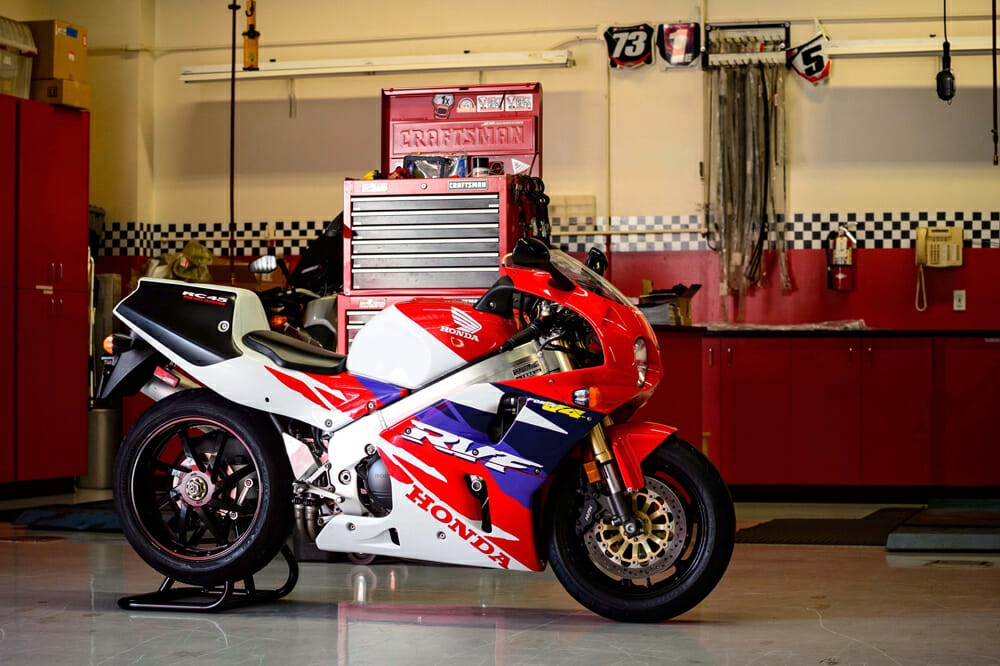 The RC45 in all its glory. This example is number 006 off the production line with only a touch over 4000 miles on the clock since 1994. It’s also likely the most pristine example of an RC45 you’ll find outside of the Honda Museum in Japan.
The RC45 in all its glory. This example is number 006 off the production line with only a touch over 4000 miles on the clock since 1994. It’s also likely the most pristine example of an RC45 you’ll find outside of the Honda Museum in Japan.
After six years, the motorcycle Honda created in the late ’80s to win the WorldSBK Championship—with which they succeeded in 1988 and 1989—the Honda RC30, was getting a bit long in the tooth.
By 1994, something more was needed to stay with the likes of the Ducati 916, the Kawasaki ZX-7R, and soon, the Suzuki GSX-R750.
That something was the glorious RC45, an evolution of the RVF750 factory racer that saw occasional duty in races like the Suzuka 8 Hour in the hands of factory-only racers like Mick Doohan and Daryl Beattie.
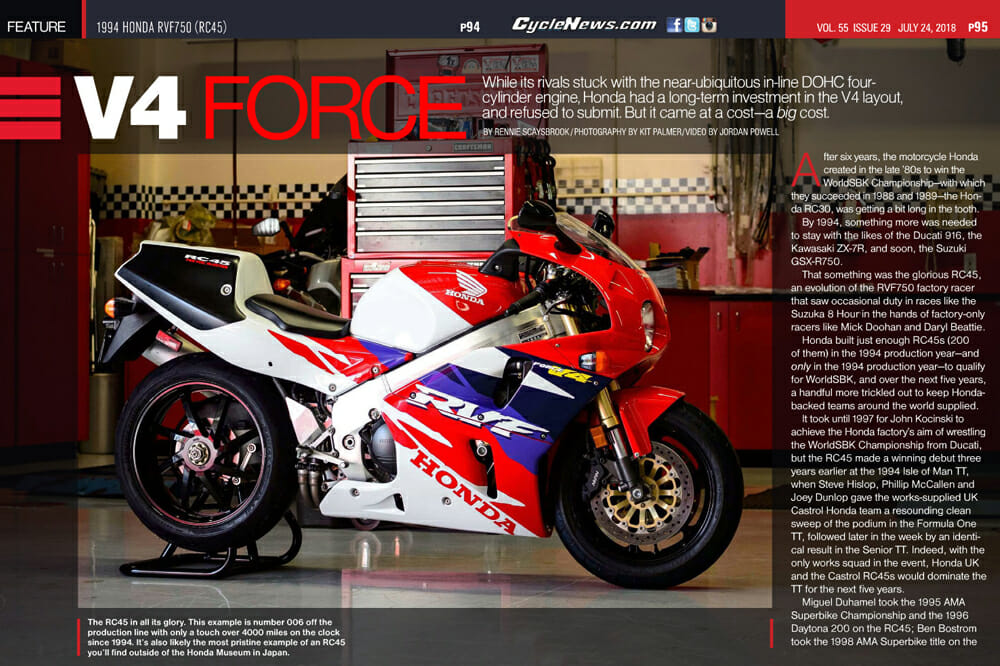
Photography by Kit Palmer
Honda built just enough RC45s (200 of them) in the 1994 production year—and only in the 1994 production year—to qualify for WorldSBK, and over the next five years, a handful more trickled out to keep Honda-backed teams around the world supplied.
It took until 1997 for John Kocinski to achieve the Honda factory’s aim of wresting the WorldSBK Championship from Ducati, but the RC45 made a winning debut three years earlier at the 1994 Isle of Man TT, when Steve Hislop, Phillip McCallen and Joey Dunlop gave the works-supplied UK Castrol Honda team a resounding clean sweep of the podium in the Formula One TT, followed later in the week by an identical result in the Senior TT. Indeed, with the only works squad in the event, Honda UK and the Castrol RC45s would dominate the TT for the next five years.
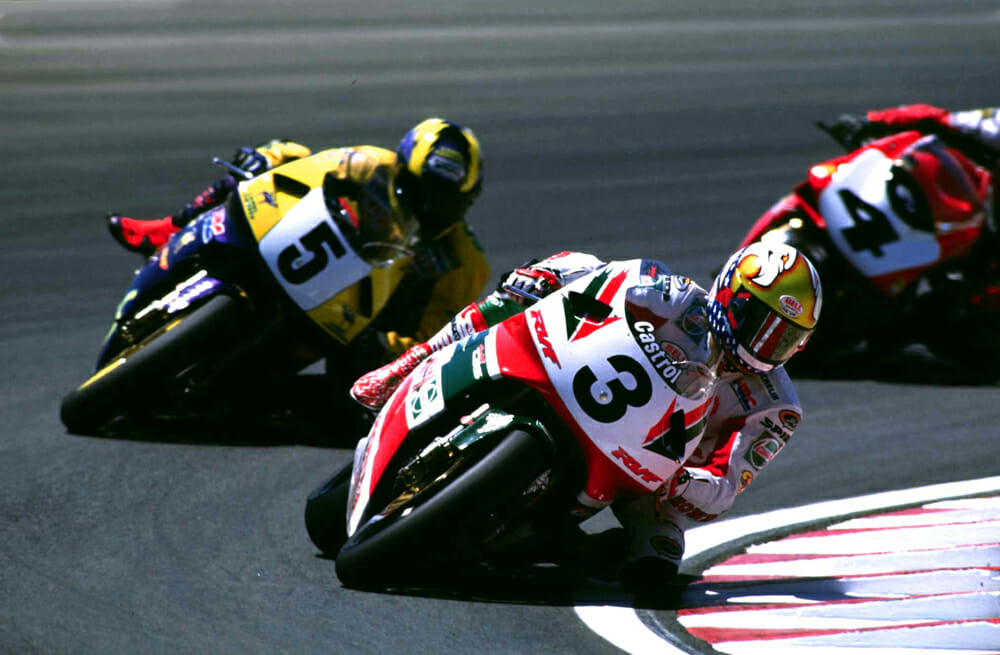 The man who conquered the RC45. John Kocinski raced just one year for Castrol Honda in 1997, took the WorldSBK title and cleared off back to 500s. Here he leads the Smokin’ Joes Honda RC45 of Miguel DuHamel at Laguna Seca in 1997.
The man who conquered the RC45. John Kocinski raced just one year for Castrol Honda in 1997, took the WorldSBK title and cleared off back to 500s. Here he leads the Smokin’ Joes Honda RC45 of Miguel DuHamel at Laguna Seca in 1997.
Miguel Duhamel took the 1995 AMA Superbike Championship and the 1996 Daytona 200 on the RC45; Ben Bostrom took the 1998 AMA Superbike title on the bike, while Aaron Slight, Kocinski, Carl Fogarty and Colin Edwards all claimed RC45 WorldSBK race glory. The RC45 also took five wins in the Suzuka 8 Hour, including three in a row from 1997-1999.
In Australia, the infamous Anthony Gobert gave the RC45 a winning debut at a wet Phillip Island round of the Australian Superbike Championship and continued his form to become (at 19) the youngest-ever winner of that title after a season-long battle with the Kawasakis of Marty Craggill and Mathew Mladin. The following year, Kirk McCarthy took over the Winfield RC45 and won the title, again from Mladin, who packed up at season’s end to come over and conquer the U.S.
The RC45 carried a price tag of $27,000, or about the same price as the Ducati 916SPS and Bimota SB7. But the promise of a works racer that was available to the public was very tempting for those sufficiently well-heeled to consider placing an order.
The reality was somewhat different.
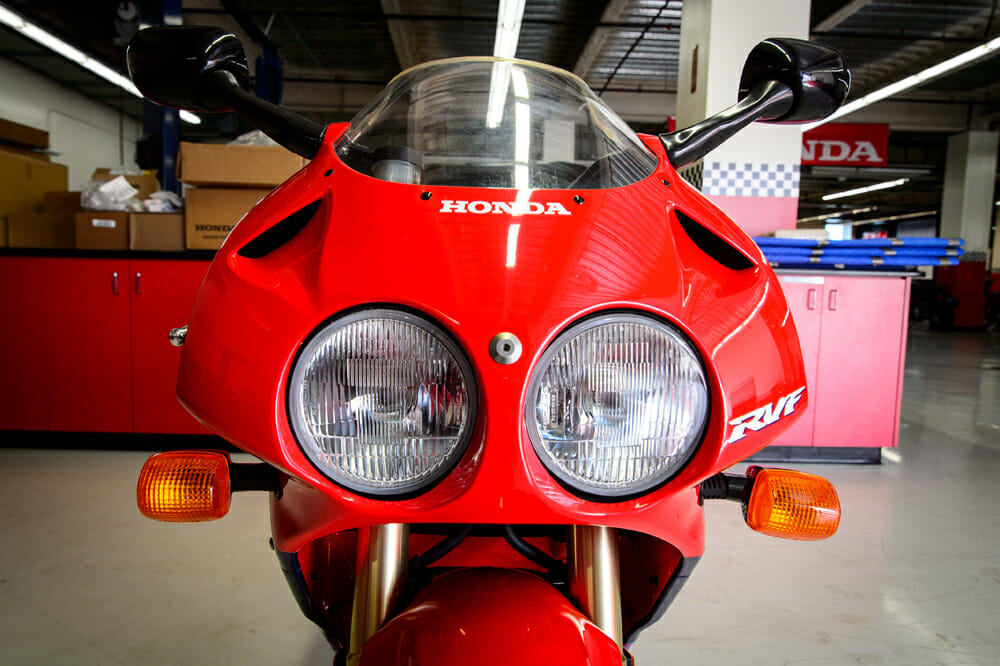 Doesn’t that twin-headlight set-up remind you of a time when life was, y’know, simpler?
Doesn’t that twin-headlight set-up remind you of a time when life was, y’know, simpler?
While the racebikes were bedecked with exotic suspension, wheels and other fitments permitted under the formulae, the RC45 sold to the public was more prosaic. The forks, for example, were similar to the CBR600, with 41mm tubes, which were on the puny side by the standards of the day. The front hoop was a 16-incher—specifically a 130/70ZR16—that by 1994, was also somewhat passé, with the opposition all running a 17-inch front, and a curious choice given the rear tire was a 190/50ZR17.
Switchgear was sourced from the Honda CBR900RR. Indeed, the existence of the CBR900RR Fireblade was somewhat of an embarrassment to Honda, as this relatively simple (and affordable) in-line four could give the RC45 a serious run for its money.
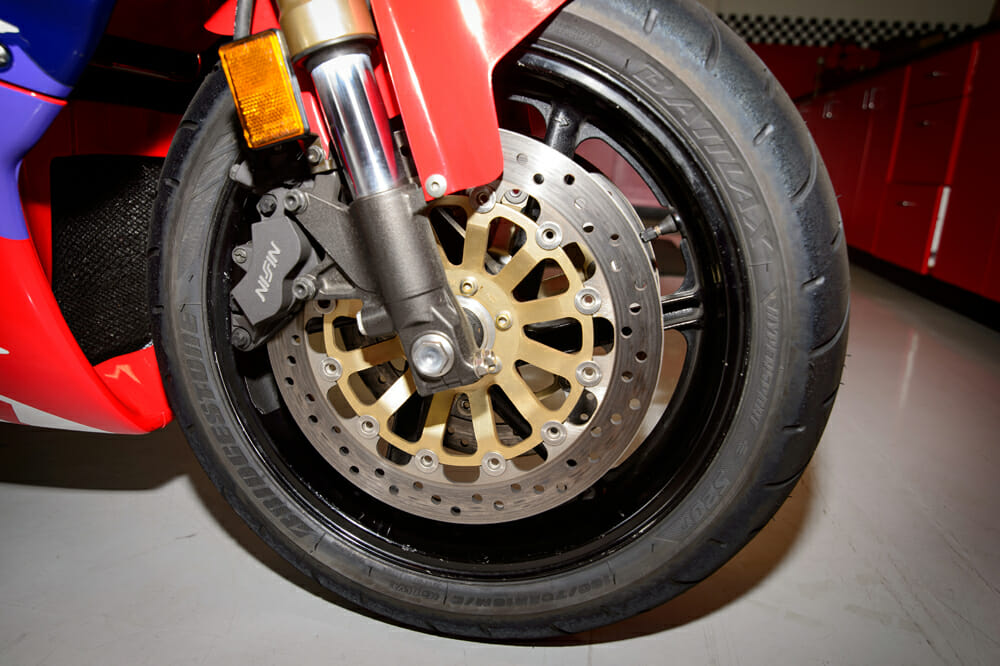 The 16-inch front wheel was outdated by the time the RC45 came to being.
The 16-inch front wheel was outdated by the time the RC45 came to being.
The RC45 was inevitably compared to its forebear, the compact and nimble RC30, but in appearance at least, it seemed bigger all-round. Whereas the RC30 perched its rider over the front, the riding position on the RC45 was more relaxed and contemporary. The seat height was 50mm lower, as was the center of gravity, which was central to Honda’s aim to get the new machine to turn into corners with more precision and less rider effort.
From the beginning of Honda’s V4 series—the VF750S of 1982—bore and stroke had been consistent at 70mm x 48.6mm, but the RC45 broke tradition with a bore of 72mm and a stroke of 46mm.
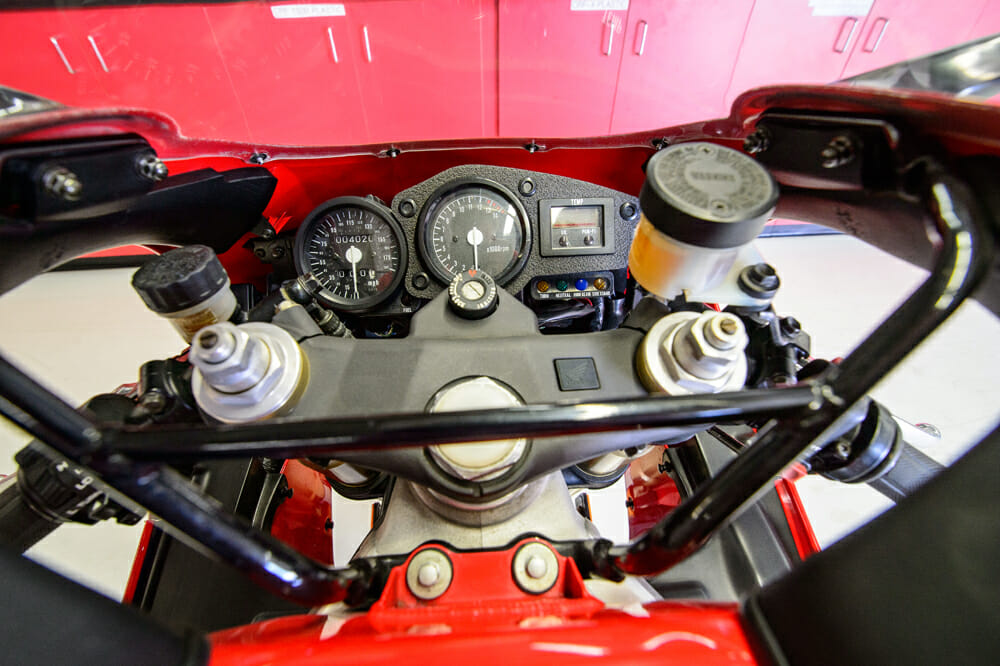 Stunningly simple. The instrument cluster of twin analog gauges reminds you this is a 25-year-old motorcycle, even if it doesn’t feel it. Watching the tacho needle swing up in unison with the V4 song is exhilarating.
Stunningly simple. The instrument cluster of twin analog gauges reminds you this is a 25-year-old motorcycle, even if it doesn’t feel it. Watching the tacho needle swing up in unison with the V4 song is exhilarating.
As on the RC30, titanium connecting rods were used, but the cylinder bores were now of what Honda called “metal composite”—a ceramic-blended aluminum that could be re-bored if required. The process saved an impressive three pounds. In the cylinder head, valve angles were reduced by a total of eight degrees. The signature gear-driven camshafts were retained in the RC45, but moved from the center to the right side of the engine, which permitted a shorter crankshaft—and more weight saving—plus a straighter passage for the inlet tracts.
The most visible change between the 30 and the 45 was in the use of a radical fuel-injection system (dubbed PGM-FI for Programmable Fuel Injection) that had been developed on the exotic oval-piston NR750. This used 46mm throttle bodies instead of the 38mm Keihin carbs with a total of seven sensors to deal with mixture control.
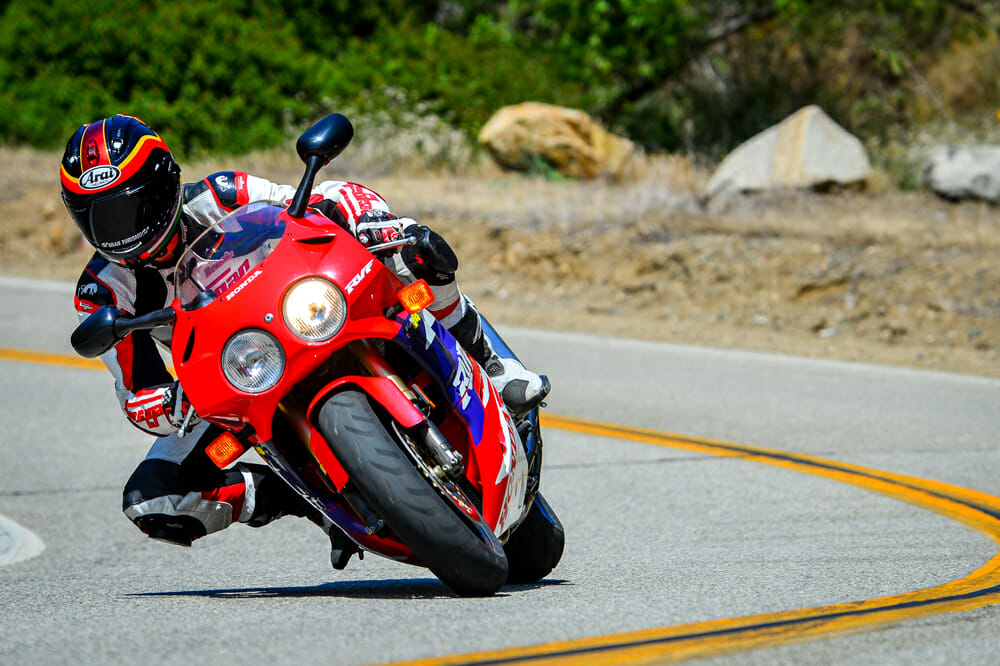 Rennie’s legs were about three sizes too long for the RC45, but hell would freeze over before we could stop him riding it.
Rennie’s legs were about three sizes too long for the RC45, but hell would freeze over before we could stop him riding it.
Chassis-wise, the RC45’s twin-spar aluminum frame used thinner-walled frame members than the RC30, supposedly to engineer more flex into the unit, although the external dimensions were larger. The frame itself was built around a large-diameter, cast-alloy steering head. Although the new machine looked larger, the wheelbase was only 5mm longer, courtesy of a longer swingarm. The swingarm itself was once again the Elf-patent single-sided unit, controlled by a fully-adjustable gas-charged shock absorber that owed much to the Honda’s successful motocross range.
At the steering end, the forks provided 24.5° trail and 3.62 inches of rake. While the RC30 used hand-laid fiberglass for the fairing, the RC45’s bodywork was in plastic. Again, more weight-saving.
With 120 hp at 12,000 rpm on tap, the standard RC45 was hardly a slouch, but an extra 30 hp was available to those who wanted to go serious racing, and could afford it. And make no mistake, some serious coin was required to make the RC45 competitive.
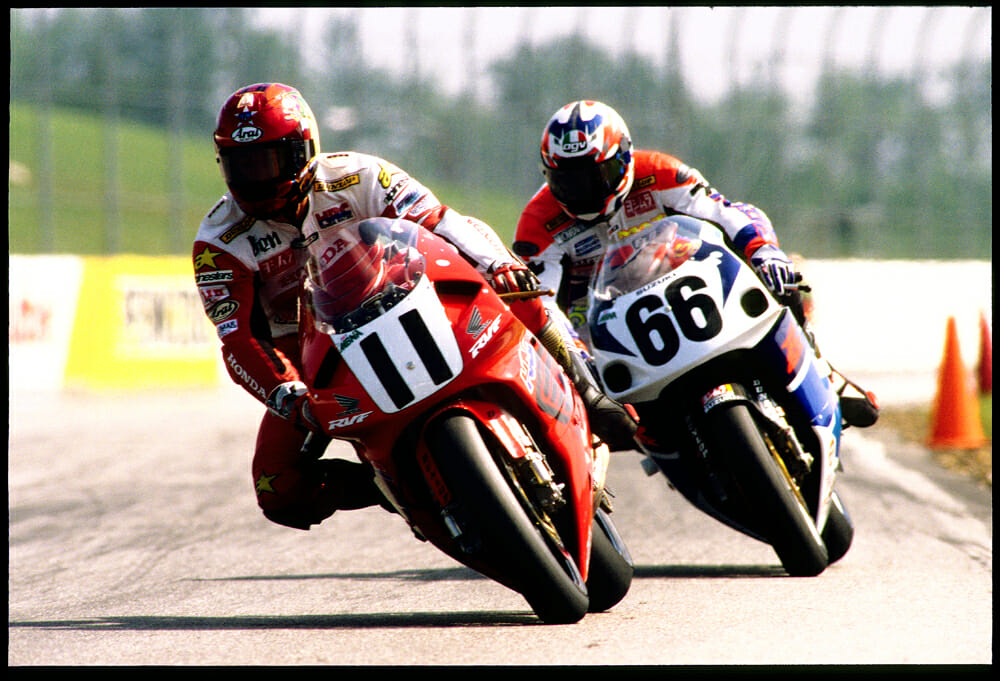 Ben Bostrom leads Mat Mladin to the AMA Superbike title in 1998. Mladin lost three national championships (two in Australia and one in the U.S.) to RC45 riders
Ben Bostrom leads Mat Mladin to the AMA Superbike title in 1998. Mladin lost three national championships (two in Australia and one in the U.S.) to RC45 riders
For this reason, few privateer teams opted for the Honda, when there were several choices available from rival manufacturers at a substantially lower cost. The genuine HRC kit parts included bodywork, wheels, forks, rear shock and linkage, clutch, complete swingarm, engine covers in magnesium, and sundry smaller items. Price? Best not to ask…
Early tests of the RC45 gave journalists plenty to think about, with the inevitable comparison to the RC30. Most agreed that the most endearing characteristic was the glorious sound—Formula One on two wheels. The snarl emanates from beneath the tank with vast amounts of air rushing in, although the tunnels running from the front of the fairing to the fuel-tank top are largely cosmetic.
The close-ratio gearbox made it a chore around town; the tall first gear requiring a handful of revs in order to pull away cleanly, and judicious use of the gearbox in traffic. But the RC45 was hardly designed with traffic in mind, except perhaps, lapped traffic. Low, steeply angled handlebars were also uncomfortable around town, but perfect for the open road.
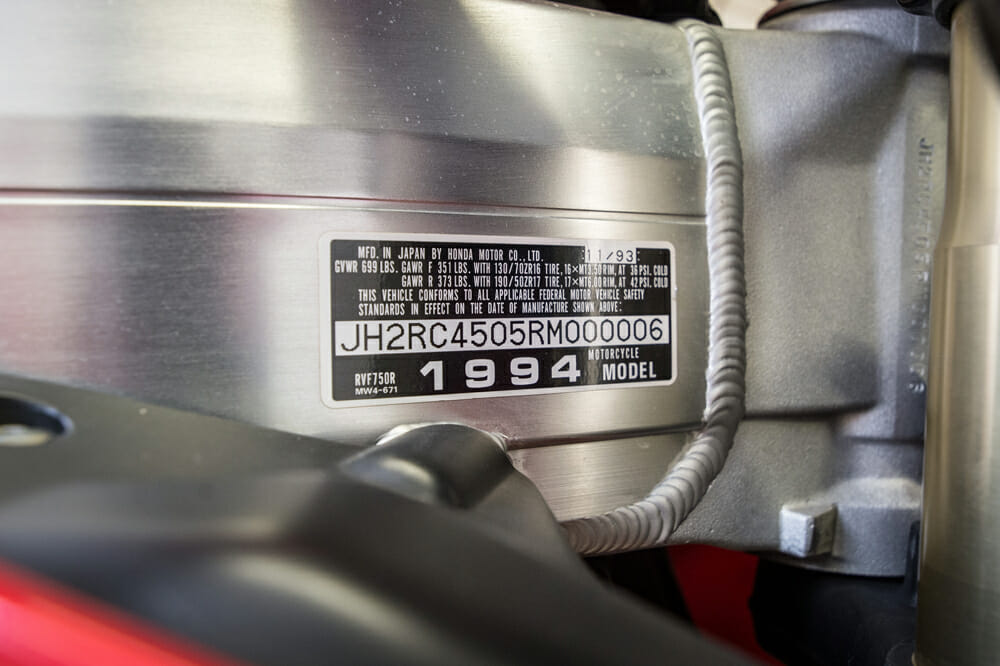 11/93: the date this particular RC45 was given birth. This one is still owned by American Honda.
11/93: the date this particular RC45 was given birth. This one is still owned by American Honda.
The engine was also somewhat cold-blooded and needed warming up, so the temp gauge showed at least 70 degrees before riding off. The choke knob mounted on the left inner fairing is actually nothing more than a fast-idle lever, as the extra richness a cold motor demands is catered for by the fuel injection system lifted from Honda’s technology showcase, the NR750. This was fed information from seven sensors measuring critical parameters such as intake air temperature, barometric pressures, and engine rpm, and then supplied the right quantity of fuel ignited by a spark at the optimum moment.
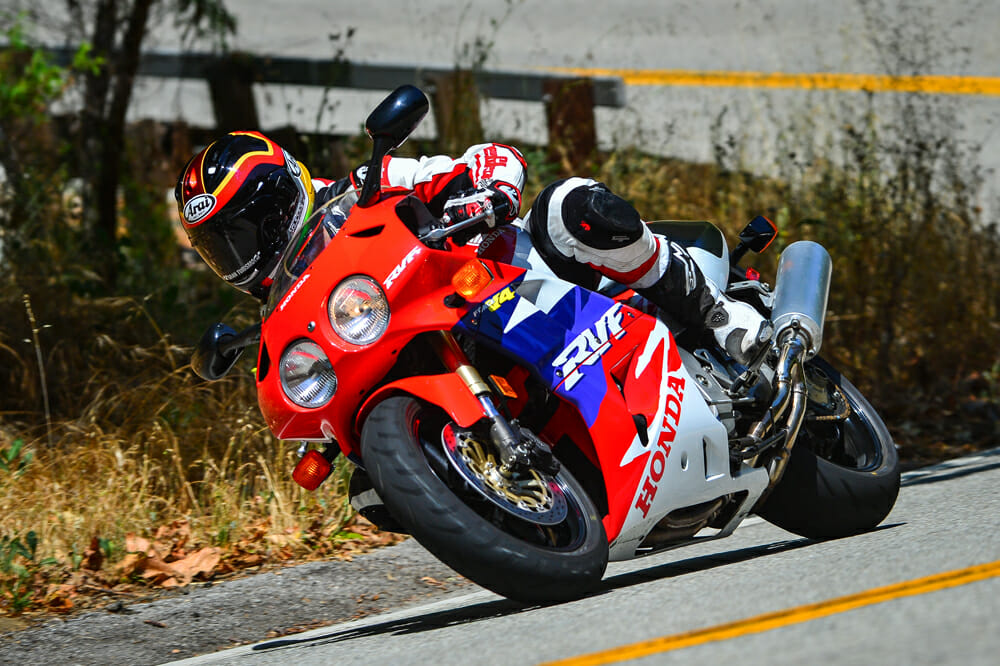 The RC45 is small, tight and oh-so-low, and makes not much sense unless you’re really hammering it. But when you are, it’s pure joy.
The RC45 is small, tight and oh-so-low, and makes not much sense unless you’re really hammering it. But when you are, it’s pure joy.
In the Saddle of History
I had a poster of the RC45 all through my high school years. It’s a bike I’ve lusted over, dreamed about, never thinking I would get the chance to even sit on one, let alone ride one.
For me, the RC45 is a mythical machine, steered by legends like Slight and Edwards, and I’ll admit I was scared it would disappoint in a “don’t meet your heroes” kind of way. I’m glad, this time, I was wrong.
There are several highlights when riding an RC45, but none, absolutely none, tops hearing that gear-driven-cam V4 at full song. It’s a flat, droning roar, so far removed from any V4 since this bike came to market.
But there’s a problem with the 45 in that Honda was greedy. Power is not what you’d call dazzling and you’ll feel all of the RC45’s claimed wet weight of 463 pounds with a full tank. The RC45 isn’t slow, but its top-of-the-heap power of 1994 makes you realize just how far we’ve come in the 25 years since. Modern Supersport 600s will run rings around an RC45.
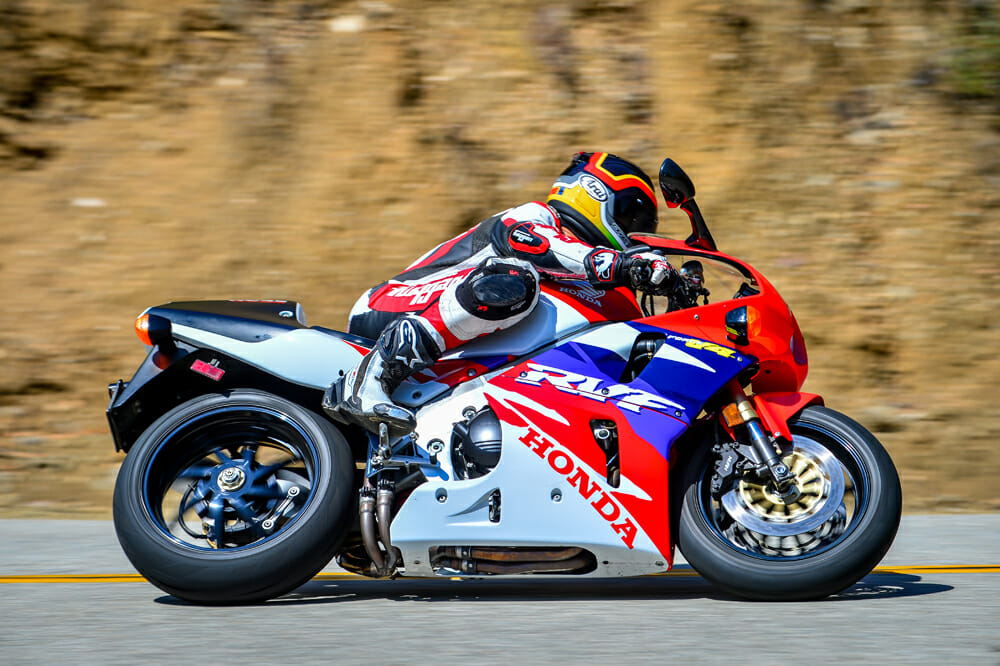 Look where you want to go and the RC45 takes you there. The 16-inch front wheel makes turn-in incredibly quick, but there’s no getting away from just how wide the RC45 is.
Look where you want to go and the RC45 takes you there. The 16-inch front wheel makes turn-in incredibly quick, but there’s no getting away from just how wide the RC45 is.
Despite the lack of outright power, the motor is incredibly smooth in its delivery for a bike with a primitive, 25-year-old fuel-injection system. There’s a bit of hesitation from a closed throttle, but I’ve ridden bikes with 2018 badges on them who have worse FI systems purely because they have to meet modern emissions standards. This was not an issue with the RC45. The power builds and builds, especially when you’re in what must be the tallest first gear the world has ever seen.
For just riding around town, you hardly need to leave the first cog, and you’ll need a very, very long stretch of road to get the RC45 singing to TT-winning speeds. But the gearbox is sweet; so, so sweet, like how a real superbike gearbox should be. The throw is short and the light “click” into each new gear as satisfying as it gets.
VIDEO | Honda RC45 Road Test
Video by Jordan Powell
There’s no getting away from the fact the RC45 is heavy, and you sit very low in the chassis. But with that 16-inch front wheel, even at its weight, it’s easy to change direction and extremely stable at speed; although, at traffic speed, you’re not even scratching the surface of what this thing can do.
Another highlight comes in the form of the dash. The twin analog tacho and speedo are from a totally different age compared to what we’re used to today, the revs sweeping up almost in unison with the speedo and the crescendo of noise from the single-outlet exhaust—it’s as 1990s as hypercolor T-shirts and Nirvana.
The RC45 is not today-level fast. But the RC has a presence about it today’s bikes can only dream of. A genuine, homologated racing motorcycle from the biggest company of all, the Honda RC45 may not have reached the racing heights demanded of it, but that doesn’t make it any less special.
I’d have one—in an instant—if only to hear that beefy, menacing drone from that gear-driven cam V4; it’s one of the sweetest sounds a machine has ever made. CN
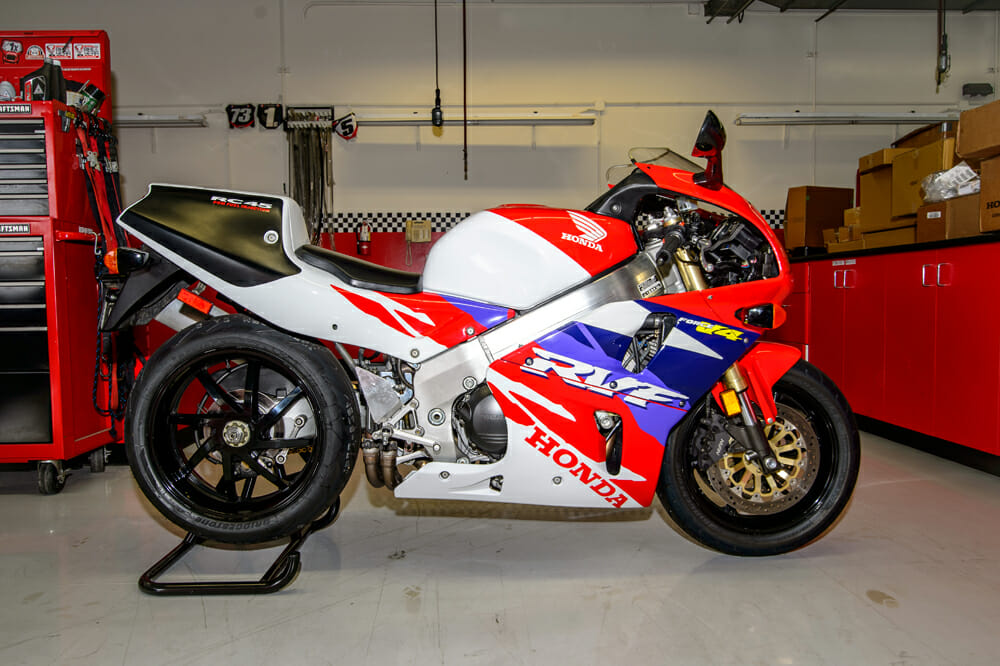
| SPECIFICATIONS |
1994 Honda RVF750 (RC45). |
| Engine: |
90-degree, 16-valve, V-4, liquid-cooled, gear-driven DOHC |
| Bore x stroke: |
72mm x 46mm |
| Capacity: |
749cc |
| Compression ratio: |
11.5:1 |
| Ignition: |
Computer-controlled digital transistorized with electronic advance |
| Fuel: |
PGM-F1 fuel injection with 4 x 46mm throttle bodies. |
| Lubrication; |
Wet sump. |
| Transmission: |
Six-speed gearbox, gear primary drive, chain final drive, hydraulically-actuated diaphragm spring clutch. |
| Max power: |
120 hp at 12,000 rpm |
| Max torque: |
56 lb-ft at 10,000 rpm |
| Max speed: |
165mph |
| Frame: |
Aluminum perimeter type with extruded triple-box spars, bolt-on alloy subframe, single-sided Pro-Am swingarm. |
| Wheelbase: |
55.5 in. |
| Front suspension: |
41mm telescopic Showa upside-down fork. Adjustable preload, and compression and rebound damping |
| Rear suspension: |
Rear suspension: Gas-charged Showa monoshock with integrated reservoir, adjustable pre-load, compression and rebound damping, adjustable ride height |
| Front wheel travel: |
4.7 in. |
| Rear wheel travel: |
5.11 in. |
| Front wheel: |
Six spoke cast alloy 3.5 x 16-in. |
| Front tire: |
Dunlop D204 Sportmax II radial 130/70 ZR16. |
| Rear wheel: |
Eight spoke cast alloy 6.0 x 17 in. |
| Rear tire: |
Dunlop Sportmax D204 radial 190/50 ZR17 |
| Front brakes: |
2 x 310mm floating discs with 4-piston Nissin calipers |
| Rear brake: |
1 x 220mm floating disc with twin-piston caliper |
| Dry weight (claimed): |
416 lbs. dry |
| Fuel capacity: |
4.75 gal. |
| Seat height: |
33.3 in. |